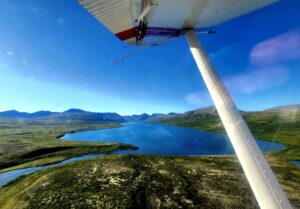
When we hear the word Alaska, our minds usually think of wilderness, bears, salmon – the wild and untamed. We also think BIG. Alaska is big. If you combined Texas, California and Montana, it would still be less than half the size of Alaska. The bears there are big. Brown bears and grizzly bears are some of the largest and most aggressive bears in the world. As far as fishing goes, people think of salmon, halibut and massive rainbows. Tenkara generally does not come to mind. But every July since 2017 Zen Tenkara has ventured to Alaska, with our small, packable, ultralight tenkara rods – and have slayed it.
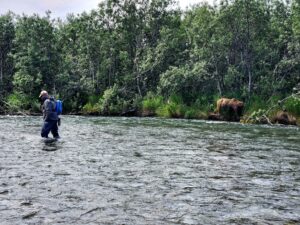
Forget the halibut, we’re talking fly fishing for trout, char, dolly varden, grayling, sockeyes, chum, silvers and yes, even kings…all on tenkara. July is a transitional month in Alaska. Fish are on the move. And unlike your scheduled dentist appointment, fish don’t adhere to a specific appointed date. One week or even one day can make a huge and dramatic difference in where fish are and what they’re doing. Are they at the mouth of a river? Have they migrated up stream? Or have they already spawned and dying? It’s the epitome of nature at work, of the life cycle observed in all its splendor. It happens according to its own mysterious schedule, in other words, it happens when it happens. A general time frame and natural sequence does exists and what you use to plan your trip. But until you get there, you never really know.
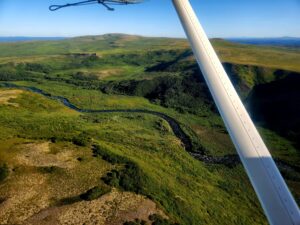
The two previous weeks before we arrived at Rapids Camp Lodge the weather had been miserable. Rainy, cold, foggy and windy. The weather made it unsafe to fly. Guests before us fished the Naknek river, mostly for sockeye which pound up stream shoulder to shoulder, like a car on a California highway in rush hour. The day we arrived the weather magically shifted. The sun came out (and basically stayed out all day and night) to provide us with ideal weather the entire week. I felt grateful to Mother Nature.
Each day at 8:00am we boarded our Beaver pontoon plane and flew to a different destination. Chums were just beginning to make their way up stream and rainbows were starting to follow. Char and dolly varden were plentiful and graylings too. Silvers were still a week or two out so we put them out of mind and focused on what was at hand.
I used to carry several tenkara rods with me when I first began these Alaskan trips. It was an experiment. A challenge. I felt I was pushing the boundaries of tenkara fishing and of Zen rods. But now, on the fist day our our 6th trip to Bristol Bay, I am confident and secure not only in the efficiency of tenkara on these waters, but also of my equipment and the Zen rod I have chosen for the trip – the Suimenka. This rod has quietly slipped into becoming my all-around favorite rod.
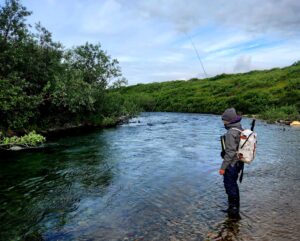
Many of the rivers that are fished in Alaska are relatively narrow. Most are lined with bushes and trees. While the river itself is usually open, getting to and from the water is a hike and sometimes requires bushwhacking. Tenkara rods make this easy business.
In the past I assumed a longer rod would be better but from years of experience, I now know that some length is good, but mostly I need backbone to control and steer these strong fish, and strength that also allows flex to take hard hits and runs that will not break the rod. The yin and yang – flexibility balanced with strength.
I practiced yoga for years and this was always the goal. Too much muscle and you loose flexibility. Too muscle flexibility and you have no strength. A balance of both is where beauty and ability come together in performance. This is what we strive for in Zen rods. The Suimenka has backbone and incredible strength, yet it also flexes deep to absorb the immense pressure these fish put on rods – particularly fixed line rods. The Suimenka is short enough that narrow bush lined rivers are easy to navigate. But can zoom long to reach and cover a bit more water on drifts and swings. The Suimenka is also a precise rocket launcher and capable of casting longer or heavier lines, and those with heavy flies or setups.
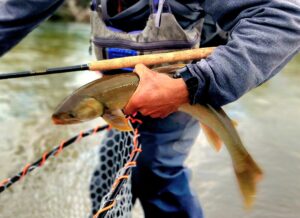
Most days we cast weighted beads on about 8ft of 8lb leader. Some days we threw a streamer pattern or even a mouse…which is incredible fun. The Suimenka offered a lot of control which helps you dial in movement in the water – bringing to life, artificial flies. That little fluttery v-motion that is irresistible to big, hungry and aggressive rainbows is easy to mimic on the Suimenka. A very soft rod would not be capable of this – or even casting in strong winds which can bend very flexible or soft tenkara rods way over.
For the last two Alaskan trips, at least one afternoon is dedicated to mousing on tenkara. Huge rainbows will come up from the deep or cross a river bed to hit a mouse, which provides a sizable meal of protein. The hit is spectacular to witness. And at that point, it almost doesn’t matter if you set the hook or land the fish. The hit alone is so completely satisfying.
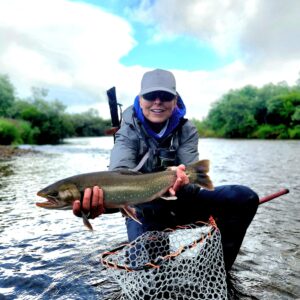
Knowing your gear and what it’s capable of is critical when planning destination trips. Not all rods are created equal. Having the correct equipment can often make or break a fishing trip. Frustration will hit hard if your rod fails on the first outing. Particularly if you have traveled a far distance. Don’t be afraid to ask the lodge or a local fly shop questions as well as the tenkara rod manufacturer:
- How big is the water you’ll be fishing
- What is the distance of the average necessary cast?
- What species am I targeting and what is their behavior (do they run, jump or tug)?
- What is the average size of the fish?
- What kind of flies will I be casting?
- What size and test of leader/tippet is necessary?
- Will I be wet wading or casting from a boat?
The answers to these questions will help you decide what kind of tenkara rod you will need to be successful. Talk you the dealer or manufacturer directly. They should be able to provide you with answers and recommendations for your tenkara fly fishing needs. And one final bit of advise – bring an extra tip section along. Whether it breaks on a fish or when collapsing the rod, or when you trip and fall after a long and tiring day of fishing, having a spare tip with you is always a good idea.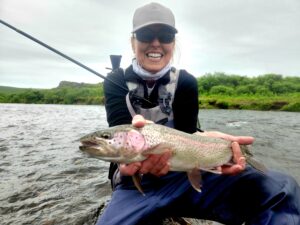
If you have an upcoming fall fishing trip or simply have questions about tenkara of fly fishing, reach out to us through our website here or call us directly at 844-TENKARA (836-5272)
Tight lines and happy fishing.



